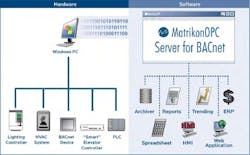With OPC, "These Walls Can Talk"
With today’s building automation systems, the walls can talk. So can the heating and air conditioning systems, the lighting, the fire detectors and the security system. They all have important information to relay about energy management, optimized operating conditions, and improved asset utilization. Unfortunately, they are all speaking different languages and running into application barriers. These systems can be connected and the obstacles overcome using standard, open protocols: OPC and BACnet. All too often people think of building systems as just heating, ventilation and air conditioning (HVAC) systems, but a truly integrated system covers much more. Modern building management monitors and operates all technical facilities: heating and air conditioning, security and surveillance, lighting, fire and safety systems and other equipment. Managing these data sources ensures optimal building performance by enabling control of building systems in an integrated manner. A major problem for organizations is inefficiencies, and the solution to that problem is enterprise systems. Fully integrating the enterprise also involves information from the systems within the buildings: plant floor manufacturing systems, energy and power monitoring equipment, utility operations and industrial control systems. The fundamental enabling component for all of this is the availability of real-time information. Integration of the systems, using standard protocols like OPC and BACnet (Building Automation and Controls network), is needed to fully realize optimization possibilities. The integration advantagesIntegration of systems, enterprise-level connectivity, and a new generation of efficient and intelligent hardware provide advantages that businesses can use to make buildings more productive and less expensive to operate. There have been numerous studies on benefits of integrating building systems. Recurring results include improved monitoring, alarming, diagnostics and troubleshooting associated with singular point of control. Other conclusions include lower maintenance costs, optimized energy usage, improved safety and/or security measures, and improved employee productivity. When the suppliers and consumers of data are specialized, an industry-specific protocol is needed for maximized control and functionality. As the data sources and end-user applications become broader and usage more varied, a more general, widely implemented protocol is preferred. The open, standard protocols BACnet and OPC fit the bill perfectly. As an industry standard, BACnet provides a level of assurance that various compliant devices from different vendors work together. It provides a set of rules that govern the exchange of information over the network. BACnet-compliant lighting, HVAC, security and other systems and devices from multiple vendors can be attached to a network, enabling single-seat, global control and access to all connected building control systems.Transform data to information Standardized access to the raw data available in the various building automation devices is only one part of the complete solution. There are significant productivity enhancements and optimization opportunities available to manufacturing operations by integrating their building automation and industrial automation systems. For example, integrated building automation systems used to monitor and control mission-critical environments can send information about the quality of the manufacturing environment to industrial control systems. Optimization tools within industrial automation systems can then correlate variations in the manufacturing environment with scheduled workflows. In the industrial automation world, OPC has long been recognized and used to provide standardized, real-time data access to disparate systems. Industrial processes and manufacturing sites produce tremendous amounts of real-time data that require transformation into useful information. In terms of using OPC to connect systems, building controls, HVAC, lighting and security devices are all assets as well. As with other industry verticals, OPC servers are available for a wide range of building automation protocols, including BACnet, LonWorks and Modbus. OPC servers provide connectivity to a wide range of advanced applications, such as decision support systems, historical analysis, process optimizations and energy calculations and other high-level information processing systems.Simplified access to real-time data and enterprise connectivity enables applications to provide optimizations such as: Centralized management systems for maintenance and energy monitoring Historical data analysis of peak demand and optimizations of utility costs Unified data processing and troubleshooting of real-time systems Standardized connectivity to cross platform and multiple vendor products Competitive system expansionThe cornerstone of an enterprise architecture that utilizes the power of the OPC and BACnet standards is an industrial-grade, OPC-compliant server that supports a wide range of BACnet functionality and configuration options. The MatrikonOPC Server for BACnet, from MatrikonOPC located in Edmonton, Alberta, Canada, provides real-time data access between OPC systems and building automation system devices supporting BACnet (Annex J compatible devices). Communication is conducted via Ethernet or serial RS-485 (providing Cimetrics USB-to-BACnet MS/TP interface) using the Cimetrics BACstac protocol layer. The MatrikonOPC Server for BACnet enables real-time data transfer from the building automation devices to the enterprise applications that transform that data to information, and information to savings.For more information visit www.matrikonopc.com.

